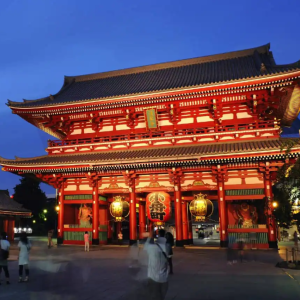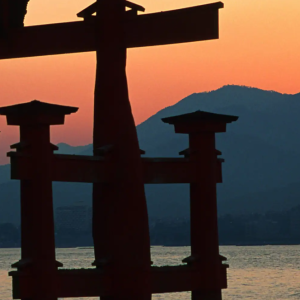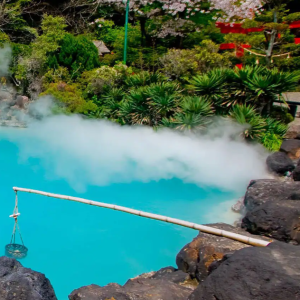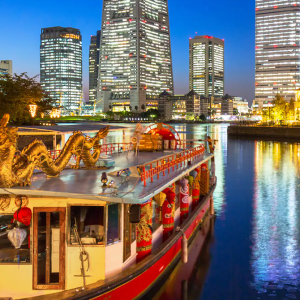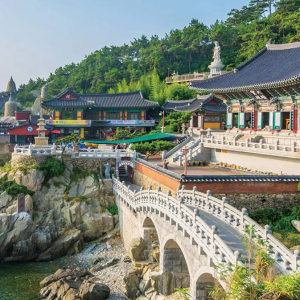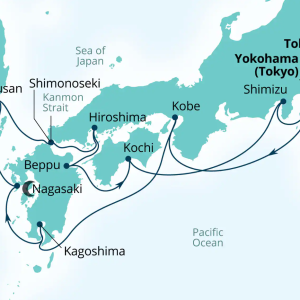14-Day Japan's Crafts & Cherry Blossoms
Seabourn | 14 Days | Tokyo to Yokohama
March 16-30, 2026
AAA Member Benefits and Special Offers:
- Member Benefit
- $200 per suite onboard spending credit
- AAA Vacations® Amenities
- $200 per suite onboard spending credit (combinable with Member Benefit)
Your Ship: Seabourn Encore
What's Included?
- Premium Spirits: Complimentary premium spirits and fine wines available on board at all times.
- Tipping:Tipping is neither required, nor expected.
- World-Class Dining: All dining venues are complimentary, dine where, when and with whom you wish.
- Complimentary Wi-Fi: Complimentary Wi-Fi packages with unlimited minutes powered by SpaceX's Starlink.
- Suites: All ocean-front suites luxuriously appointed, most with a private veranda.
- Entertainment:Complimentary entertainment experiences, offering a variety of shows and live music.
Day 0 (MAR 16): Tokyo, Japan
Welcome to Japan’s cutting-edge capital, the world’s largest city famed for its blazing neon, techno-gadgets, and serious fashion sense. Get a glimpse into Tokyo’s glorious past while strolling the Imperial Palace gardens, or take a rickshaw ride through the Asakusa district with its ancient Sensoji Temple and colorful atmosphere that echoes Old Edo. Wander the Tsukiji Market — aka, “Tokyo’s Kitchen” — the world’s largest fish and seafood market, and raise a glass of rice lager at the Philippe Starck-designed Asahi Beer Hall located near the 2,080-foot-high Skytree, the world’s tallest tower. You can shop for fashion-forward trends in Shibuya before heading to the rooftop garden that crowns Shibuya Scramble Square for outstanding views of Mount Fuji. If you think Tokyo buzzes by day, wait until you see it at night — so take advantage of a late-evening departure to soak in all of Shinjuku’s razzle dazzle, explore Akihabara’s gadget shops and gaming arcades, or join in Japan’s favorite pastime at one of Roppongi’s karaoke bars.
Day 1 (MAR 17): Day at Sea
Day 2 (MAR 18): Kobe, Japan
Once the busiest port in Japan, this attractive city was devastated by an earthquake in 1995 and even after rebuilding never regained its maritime dominance. Nevertheless, its ultra-modern Harborland, crowned by the Kobe Port Tower offers a warm welcome to the Kansai district of Japan. Kansai is ruled by a trio of Japan’s most important cities: Kobe, Osaka and Kyoto. One of the first cities in Japan opened to trade, Kobe has a cosmopolitan air that includes a venerable Chinatown and a section of 19th-Century Western-style buildings in the Kitano neighborhood. The city’s history began in the 3rd-Century with construction of the Ikuta Shrine. Many visitors ascend looming Mt. Rokko via the Shinkobe Ropeway, for panoramic views over the city and the glass-domed Nunobiki Herb Garden on the slopes. The Arima Onsen hot springs right in Kobe is one of Japan, most famous spas. Massive Osaka is the largest of the trio of cities, with over 2.5 million people and attractions of its own including a reconstructed castle, the impressive Kaikuyan Aquarium and the odd-ball Momofuku Ando Instant Ramen Museum commemorating the man who invented the ubiquitous cup-of-noodles. The richest repository of Japanese culture, however, is centered in Kyoto, where a UNESCO World Heritage Site encompasses no fewer than 17 structures as the Historic Monuments of Ancient Kyoto. Castles, gardens, temples and other treasures abound, and make a compelling reason for visitors to make the pilgrimage from Kobe for the day.
Day 3 (MAR 19): Day at Sea
Day 4 (MAR 20): Kagoshima, Japan
Tucked into a deep-cut bay at the southern end of Kyushu Island, this port has been compared to Naples in Italy, because it is also dominated by views of an active stratovolcano, Sakurajima. Enjoy its magnificence from the Shiroyama Observatory, or from the tranquil Edo-period Senganen Japanese Garden. Ishibashi Park has three Edo-era stone bridges, of five originally built at the end of the 19th century. Near the port is the impressive Kagoshima Aquarium, with seven floors of displays including the massive Kuroshio Tank maintaining a current that sustains large specimens including a whale shark.
Days 5-6 (MAR 21-22): Nagasaki, Japan
Nagasaki’s fine natural harbor on Kyushu island was mostly of local interest until Portuguese explorers landed there in 1543. It quickly flourished as a trading center for European and Asian merchants, which continued throughout its history. It also developed into an important industrial center. Because of its open status, the city harbored a significant Christian community, as well as a bustling Chinatown. During World War II, Nagasaki’s concentration of military and industrial sites made it a target of repeated Allied bombing raids, culminating in a nuclear bombing on August 9, 1945, the second, and to date the last use of a nuclear weapon in war. As in Hiroshima a few days before, the devastation from the aerial explosion of the “Fat Man” plutonium bomb was horrific. An area of over 2.5 square miles was flattened, and about 80,000 people were killed directly, with an equal number suffering injuries. Now rebuilt, and with a thriving industrial and shipbuilding economy, Nagasaki still attracts visitors with the relics of its history up to and including the atomic bombing.
Day 7 (MAR 23): Busan, South Korea
Home to approximately 3.4 million people, Busan is a fast-moving coastal metropolis that guarantees you’ll never have the same experience twice. History enthusiasts will find themselves captivated by the stunning historical treasures of Beomeosa Temple, a serene oasis nestled within the city, with a rich heritage that dates back over 1,300 years. No trip is complete without strolling through Yongdusan Park to take in panoramic views while marveling at the iconic Busan Tower, a symbol of the city's aspirations and dynamism. Busan's culinary scene is a highlight of any visit. Savor the city's diverse gastronomy by exploring its bustling markets like Jagalchi Fish Market, where you can feast on freshly caught seafood, and indulge in delectable Korean street food. The city's natural beauty is another compelling reason to visit, with its pristine beaches like Haeundae Beach offering a tranquil escape by the sea. For those seeking a glimpse of Busan's ecological diversity, Dongbaek Island's ecological park features coastal walks and panoramic ocean views. Whether you’re drawn to studying the city's past and or its constant evolution, this destination appeals to a wide range of interests and tastes.
Day 8 (MAR 24): Shimonoseki, Japan
Day 9 (MAR 25): Hiroshima, Japan
Hiroshima means “wide island” in Japanese. The city was established in the 16th Century on Japan’s largest island, Honshu, and grew into an important shipping center and prefecture capital, boasting a fine castle. Although it was an important city in Japan throughout the imperial period, its reputation in the greater world was burned into history when it became to target of the first atomic bombing of a civilian target in August of 1945. The United States airplane Enola Gay dropped a nuclear device nicknamed “Little Boy” on the city that morning, obliterating everything within a two-kilometer radius and directly killing 80,000 people. Approximately 70 percent of Hiroshima’s buildings were destroyed. Within a year, injury and radiation illness had killed an additional 90, 000 to 116,000 citizens. The attacks on Hiroshima and nearby Nagasaki quickly led to the surrender of Japan and effectively precipitated the end of World War II in Asia. Within a few years, Hiroshima had begun to rebuild, and the city became the focus of an international movement to eliminate nuclear weapons from future wars. Relics of its past such as the impressive Hiroshima Castle and the tranquil Shukkeien Garden were rebuilt, and the city undertook the construction of a Memorial Peace Park, which today attracts visitors from around the world. The park, which holds a museum and a memorial “Atomic Dome” constructed on the closest remaining building to the blast site, is a moving and impactful place of pilgrimage in this re-born City of Peace. One notable feature is a colorful memorial to Sadako Sasaki, a young woman whose dying wishes for world peace were recounted in the story A Thousand Paper Cranes.
Day 10 (MAR 26): Beppu, Japan
This unparalleled hot spring haven makes for an extraordinary spa day. Celebrated for its remarkable abundance of thermal waters, an array of baths each offering a unique experience – from ordinary hot water baths to rejuvenating mud baths, natural exfoliation in sand baths, and detoxifying steam baths. On cold days and cooler nights, visitors can get a better idea of just how abundant the baths are as the steam rises from the healing waters dances throughout the city. Additionally, the “Hells of Beppu” offer tours of bubbling hot springs for viewing, not bathing. Witness the earth's raw power as it steams, boils with vibrant hues, and showcases the colorful magic of vivid mineral deposits. Beppu is the perfect destination to pause your busy travel schedule, immerse in relaxation and reconnect with nature and yourself.
Day 11 (MAR 27): Kochi, Japan
Japan’s Shikoku island is a popular place of pilgrimage among Japanese Buddhists. Kochi has three of the 88 temples on the route. Chikurinji Temple, with its five-story pagoda, is one of them. Located on Mount Godaisan, it also features an adjacent botanical garden. The town is most famous for its castle, originally built in the early 17th century, but largely rebuilt following a fire in the mid-18th century. It is one of only 12 existing feudal-period castles in Japan. South of the town, Katsurahama beach is a popular destination, although swimming is not allowed due to strong currents. A picturesque shrine located on a high point overlooking the sea is the perfect postcard image of rural Japan. The beach is also a good spot to enjoy Katsuo no Tataki, the traditional local dish of lightly grilled and seasoned bonito tuna.
Day 12 (MAR 28): Day at Sea
Day 13 (MAR 29): Shimizu, Japan
A busy port located on the Suruga Bay, Shimizu is renowned for the surrounding views of Mt. Fuji. One of the most famous is from Miho no Matsubara, a shoreline lined with groves of lovely pine trees that is a UNESCO Cultural Heritage Site. One tree, said to be over 650 years old, plays a part in a popular folkloric myth. On clear days, the snow-capped cone can also be viewed from the heights of the Nihondaira Plateau overlooking the city and the bay. Near the port, the four-story S Pulse Dream Plaza shopping mall boasts a museum dedicated to sushi!
Day 14 (MAR 30): Yokohama, Japan
The port of Yokohama provides seamless access to Tokyo, Japan’s capital and the most populous city on earth. There is more than enough variety in Tokyo to occupy a lifetime. Peruse the historic and immaculate Imperial Palace and Gardens before hitching an enchanting rickshaw ride through the lanterns and statues of the Asakusa district and its Sensoji Temple. Roam the city on a scavenger hunt for architectural oddities such as the Skytree Tower and the Tokyo Dome entertainment complex. Ever the paradise of cultural contrasts, Tokyo offers both classical entertainment like traditional kabuki performances, or the astonishing quirkiness of the teenaged fashion, cosplay and anime-fans along Takeshita Dori in Shinjuku.
All pricing and offers for accommodations and other non-air travel are per person, based on double occupancy, capacity controlled and subject to availability and change without notice. Pricing does not include taxes, fees, fuel surcharges, gratuities, resort fees, or airfare unless otherwise noted and is valid on new bookings only. Prices, fees, and other restrictions are subject to supplier policies. All offers, including but not limited to, bonus amenities, upgrades, prices, and group benefits are based on select dates, resorts, room categories, and/or fare codes. Specialty pricing may require proper identification. Cancellation penalties, blackout dates, and other restrictions may apply. When traveling outside the United States a valid passport is required. It is the sole responsibility of the passenger to have the proper documentation and identification required by the United States and other governments at the time of travel. When passports are required, it must be valid for a minimum of six months past your date of return. AAA strongly recommends the purchase of Travel Insurance. Usage of a credit card for travel arrangements may provide additional protection, please consult your credit card policies. Under certain circumstances the package price may be subject to supplemental price increases imposed by the supplier. Price increases include, but are not limited to fuel surcharges, taxes or fluctuations in foreign exchange markets that may be imposed after the date of purchase. Air-inclusive prices do not include government imposed taxes and fees, including but not limited to a September 11th Security Fee, U.S. or international government imposed taxes and fees, Federal Excise Fees, among others. Some carriers charge additional fees for checked bags, fuel surcharge, meals, etc. Please check the carriers website for details. Air-inclusive pricing is based on select departure cities. Prices from other cities may vary. AAA Oregon/Idaho acts solely as a sales agent for travel suppliers and is not responsible for the actions or inactions of such suppliers. We monitor all of the information presented on our website; however, we do not assume responsibility for any errors or omissions in the content of the offers displayed. Review full Travel Disclosure and Consent at time of booking.
 Click Here to View Your Vacation
Click Here to View Your Vacation
